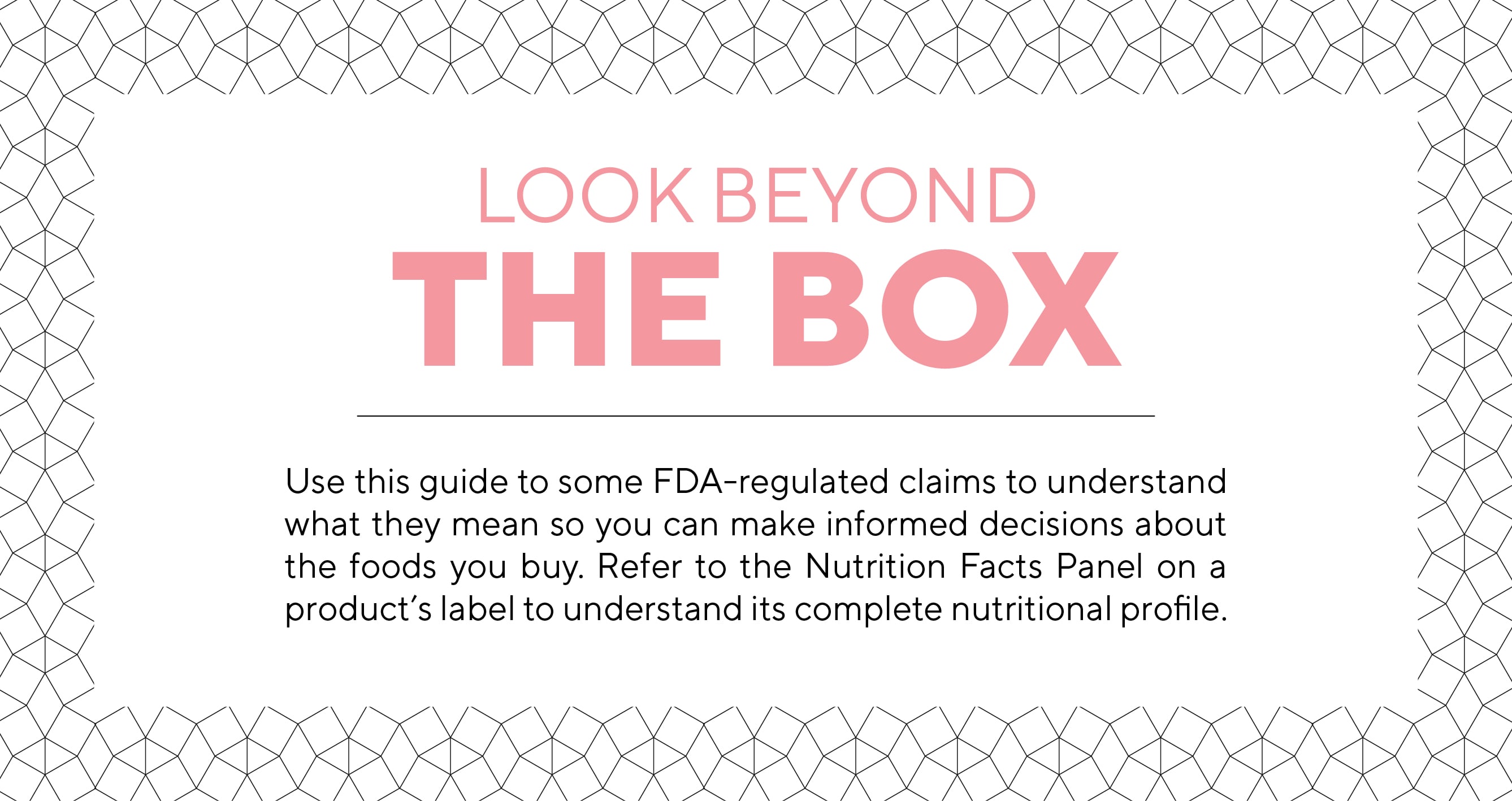Updated July 1, 2022
Health and wellness advice abounds on YouTube, Instagram, TikTok, and websites. You probably know that this advice is more than likely fake, but how can you sort fact from fiction? First, consider whether the source is science-based research reported by an expert in that area, or merely an opinion from an influencer. We have a team of experts—registered dietitian nutritionists—who continually work to provide the most current health and wellness information to our customers. Let’s explore some tried-and-true ways to steer clear of nutrition misinformation.

6 red flags.
You may be concerned with your health and are looking to feel better, manage stress, and improve your mental health. When searching for information about health and wellness, look out for these six red flags.
- Quick fixes: Can you really lose 15 pounds in one week? Will you get slim without exercise? If it sounds too good to be true, it probably is. There are no quick fixes—only long-term habits to improve your health and feel good.
- Diets or eating styles, such as keto and paleo, that exclude food groups: Since each food group provides certain nutrients as part of a balanced diet, omitting an entire food group may affect the way you feel or even result in nutrient deficiencies.
- “Good” or “bad” foods: This sort of labeling is too simplistic. Most foods, eaten in appropriate portion sizes with an overall healthy eating pattern, can be part of a balanced diet and contribute to your overall health and well-being.
- Scapegoats or cure-alls: Be skeptical if one component, such as sugar, is blamed for multiple health issues. Additionally, claims that certain products, such as a single supplement, can give you clear skin or eliminate stress are often untrue.
- Single-study recommendations: Credible nutrition recommendations usually come from years of research and multiple studies. Also beware of controversial headlines that grab your attention but don’t tell the whole story.
- Social media influencers: Even though their content is fun or interesting, don’t be afraid to fact-check what they say. Often influencers are paid by companies to promote products.1
Online search tips.
Health claims about foods and nutrients may be biased depending on the source. While looking for nutrition information, keep in mind that websites ending with, .edu (an educational institution), .gov (a government agency), or .org (a nonprofit) tend to be more reliable sources.2
Ask these questions as you read blogs and watch videos.
- How does the information compare to recommendations from multiple reputable health organizations? If it doesn’t align, the information may not be science-based.
- How current is the information? Science constantly evolves, so it’s important to seek the latest research on the topic. Even if the information has not changed in a long time, the site owner should indicate that it has been reviewed recently to ensure the information is still valid.
Check out these credible websites:
- For general nutrition information, try MyPlate.gov or the Academy of Nutrition and Dietetics at EatRight.org.
- Get facts on fad diets: https://www.eatright.org/health/wellness/fad-diets
- For heart-smart tips, consult the American Heart Association at heart.org.
- To help manage and prevent diabetes, check out the American Diabetes Association at diabetes.org.
- The Celiac Disease Foundation at celiac.org is a great resource for gluten-free diets.
- For plant-based, vegetarian, or vegan diets, take a look at the Vegetarian Resource Group at vrg.org.
- Learn about herbs and supplements at the National Institutes of Health’s National Library of Medicine.
Dietitians: authors with authority.
When it comes to nutrition expertise, there are two credentials you can count on: registered dietitian (RD) and registered dietitian nutritionist (RDN). Also known simply as dietitians, RDs and RDNs are food and nutrition experts who have met high academic standards. They've completed supervised practice and passed a national examination to obtain their registration.3 Articles written by dietitians are more likely to be credible.
You can trust the experts.
While many people use the terms dietitian and nutritionist interchangeably, there is a difference. Dietitians have met rigorous requirements to earn their credentials. However, in some states there is little or no regulation of titles such as nutritionist or nutrition coach. Because someone claims to be a nutritionist, health coach, or wellness consultant on Instagram, YouTube, TikTok, or elsewhere does not make them qualified to recommend food choices or guide your wellness journey.
There are many other nutritional credentials out there, so find out the standards of obtaining the credential before taking advice. Our Publix registered dietitian nutritionists translate the science of nutrition into practical solutions for healthy living.
Look for our Better Choice shelf tags.
Better Choice shelf tags can help you make small shifts in your food choices within certain categories of products. When compared to similar products, the tags identify items that have more of the nutrients you need, like fiber, and less of the things you don't need, like saturated fat, or added sodium, or added sugar.
Our dietitians stay on top of the latest research and use it when assessing products for Better Choice tags. As nutrition science advances, they continually re-evaluate the nutritional criteria and groups of similar products. Read more about Better Choice.
The claims game.
Certain claims on product packages, such as healthy, low-carb, fat-free, or no added sugar may lead you to believe that the product is better for you than others. The truth is that what’s inside the package may not meet your nutritional expectations or goals.
Manufacturers may take the opportunity to market their products with unregulated—or even regulated—claims that may not be as good as they sound. Do your research. Beware of these claims because they are not defined and regulated by the Food and Drug Administration (FDA). The following are examples of unregulated claims that have not been defined by the FDA or USDA.
- Low-carb
- Keto-friendly, keto
- Paleo-friendly, paleo
- Clean label
- Dairy-free
- Non-GMO
- Plant-based
The following are claims that have been defined by the FDA.
- Calorie free: less than 5 calories per serving
- Low calorie: 40 calories or less per serving
- Fat free: less than 0.5 g of fat
- Saturated fat free: less than 0.5 g of saturated fat
- Low fat: 3 g or less of total fat
- Low saturated fat: 1 g or less of saturated fat
- Reduced fat or less fat: at least 25% less fat than the regular version
- Sodium free or salt free: less than 5 mg of sodium per serving
- Very low sodium: 35 mg of sodium or less
- Low sodium: 140 mg of sodium or less
- Reduced sodium or less sodium: at least 25% less sodium than the regular version
- Sugar free: less than 0.5 grams (g) of sugar per serving
- Reduced sugar: at least 25% less sugar per serving than the regular version
- No sugar added or Without added sugars: no sugar or sugar-containing ingredient is added during processing
- High fiber: 5 g or more of fiber per serving
- Good source of fiber: 2.5 g to 4.9 g of fiber per serving4
Reliable recipes for you.
As you sift through recipes and meal ideas on Pinterest, YouTube, and blogs, consider the source and the process to publish them. Sometimes a recipe does not turn out the way it looks in the photo or sounds in the description because it wasn’t tested.
Publix Aprons® recipes are developed by our chefs and tested in our kitchens to ensure that each recipe is reliable and delicious. Our dietitians create recipe criteria for certain dietary considerations based on the latest food and nutrition science, including the 2020–2025 Dietary Guidelines for Americans. If you’re looking for recipes that fit your wellness goals, search our library of Publix Aprons recipes to discover what’s right for you.
We have refreshing drink recipes with no added sugar, including Thai-Style Tea Dalgona Coffee, and Cardamom-Citrus Coffee Spritzer.
- Thai-Style Tea Dalgona Coffee is a whipped coffee trend taking over the internet. Traditional versions of Dalgona coffee call for 2 tablespoons of sugar—almost half the daily recommended allowance of added sugars per day (24 grams of sugar/50 grams of sugar recommended per day). Make this version that has zero grams of added sugars.
- Try our Filipino-Style Glazed Mushrooms and Stir-Fried Garlic Cauliflower Bowl for a flavorful and filling vegetarian meal.
- Cardamom-Citrus Coffee Spritzer is a refreshing take on an iced coffee, with lemon and cardamom and no added sugars.
For the love of you.
Choosing how you eat is uniquely personal. It’s about your needs, your preferences, and your goals. As your wellness ally, we're in your corner with fresh ideas, recipes, and wellness icons that make it easier to shift toward wiser food choices. It’s all about you, at your very best.
Sources
1 Bellows, L., and R. Moore. Nutrition Misinformation: How to Identify Fraud and Misleading Claims. Colorado State University. Accessed March 30, 2022.
2 U.S. Department of Health & Human Services (HHS). How to Evaluate Health Information on the Internet: Questions and Answers. National Institutes of Health: Office of Dietary Supplements. June 24, 2011.
3 Academy of Nutrition and Dietetics. What is a Registered Dietitian Nutritionist. EatRight.org. Accessed March 30, 2022.
4 Guidance for Industry: Food Labeling Guide. U.S. Food & Drug Administration (FDA). January 2013.

 You are about to leave publix.com and enter the Instacart site that they operate and control. Publix’s delivery and curbside pickup item prices are higher than item prices in physical store locations. Prices are based on data collected in store and are subject to delays and errors. Fees, tips & taxes may apply. Subject to terms & availability. Publix Liquors orders cannot be combined with grocery delivery. Drink Responsibly. Be 21. For prescription delivery, log in to your pharmacy account by using the Publix Pharmacy app or visiting
You are about to leave publix.com and enter the Instacart site that they operate and control. Publix’s delivery and curbside pickup item prices are higher than item prices in physical store locations. Prices are based on data collected in store and are subject to delays and errors. Fees, tips & taxes may apply. Subject to terms & availability. Publix Liquors orders cannot be combined with grocery delivery. Drink Responsibly. Be 21. For prescription delivery, log in to your pharmacy account by using the Publix Pharmacy app or visiting 


